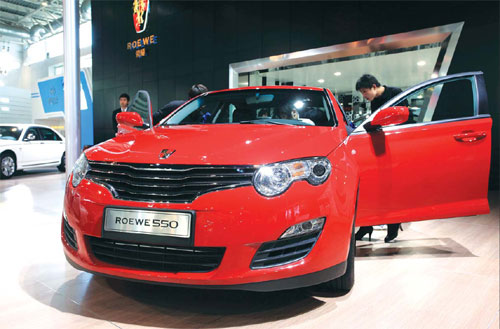Survey: Sharp rise in domestic car quality
Updated: 2012-09-17 07:57
By Jacob George (China Daily)
|
|||||||||||
|
SAIC's Roewe was the 2009 champion in JD Power's sales satisfaction study, prized recognition for a home-grown brand. But even as "hard" quality improves, domestic brands continue to lag well behind foreign names in the "soft" component of consumer perception. Provided to China Daily |
Yet feedback from owners continues to favor foreign automakers
With their reputation for building poor-quality passenger vehicles, China's domestic automakers are the frequent target of criticism by global automotive executives, industry experts and media critics.
But based on the feedback from the most important critics - actual owners of the vehicles - the story is not so simple.
It is true that individually and as a group, Chinese-brand vehicles have traditionally not performed well compared to their international competitors in the JD Power and Associates' annual China Initial Quality Study that tracks actual quality problems - known as "hard" quality problems - experienced by Chinese consumers in the first three to six months of vehicle ownership.
Some of the most common actual problems with Chinese vehicles include such things as difficulty getting the vehicle into gear, the engine losing power when the air-conditioner is on and the vehicle pulling noticeably to one side or the other while driving.
To understand where China falls behind the competition in quality, however, requires a deeper dive into the research data.
Once we scratch below the surface, a surprising discovery becomes apparent: While it is true that Chinese domestic brands trail their international counterparts in actual quality, they are making steady and rapid progress, and continue to close the gap with their international counterparts.

For example, in the JD Power quality study of 2000, new Chinese-brand vehicles averaged 8.34 actual problems per vehicle. By comparison, new international-brand vehicles sold in China averaged 4.38 problems per vehicle. This means that home-brand vehicles, on average, experienced 4 more real problems per vehicle compared to their international competitors.
Reducing the gap
By 2011, however, JD Power's quality study data shows the average problems per vehicle for all domestic brands declined to 2.32, compared to the figure of just 1.31 for international brands. Clearly, the overall gap in real quality between Chinese and international vehicles is closing.
Perhaps just as important as the hard quality improvements by Chinese brands, is the outlook for the future.
Based on trend analysis of the actual quality gains in the past decade, we estimate that the China's domestic brands can potentially achieve parity with international brands by 2018, or perhaps even sooner. That is good news for Chinese automakers.
While advances in the overall hard quality of Chinese-branded vehicles appears undeniable, it is in the area of "perceived" quality - also known as "soft" quality - that Chinese domestic brands are having a tougher time closing the distance with their international counterparts.
That finding is based on results of JD Power's annual Automotive Performance, Execution and Layout Study in China.
Rather than collecting tangible examples of things that have gone wrong with a vehicle, the study measures what consumers think or feel about their cars - including subjective likes and dislikes - and assigns a numerical value to the responses. The higher the vehicle's numerical score, the more favorably the vehicle is viewed by consumers.
Perceived quality
Examples of perceived quality include impressions about a vehicle's exterior or interior styling, the quality of materials used in a vehicle, the design and feel of buttons and switches, the effective use of space to accommodate passengers or cargo, and many other attributes.
For Chinese-brand vehicles, some of the lowest scoring categories include the perceived quality of seats and other interior materials, quietness over bumps, the sound and performance of the engine during rapid acceleration, and the audio and temperature controls.
According to JD Power's most recent performance study results from 2011, Chinese vehicle makers scored below their competitors from Europe, Japan, South Korea and the United States in all 10 categories researched in the study.
Perhaps of even greater concern for Chinese automakers is that since the launch of the China automotive performance study nearly a decade ago, as a group, domestic brands have always trailed their international competitors.
Possibly most disconcerting of all is that over this period, research data indicates that the "perceived quality" gap between Chinese brand and their foreign counterparts is not getting smaller. This means that while the "soft quality" of domestic-brand vehicles continues to improve, it is not improving fast enough to catch up with the foreign competition.
Certainly, some Chinese automakers have invested tremendous amounts of time, money and manpower into improving the "soft quality" of their vehicles, and their efforts show.
But to become truly competitive in growing their businesses and defending their home turf, China's domestic automakers are going to need to take a holistic approach to vehicle development process, one that includes not only reducing the number of engineering shortcomings in their vehicles, but also designing in quality that appeals to the sensitivities and visceral needs of consumers.
The writer is the vice-president and general manager of JD Power and Associates.











